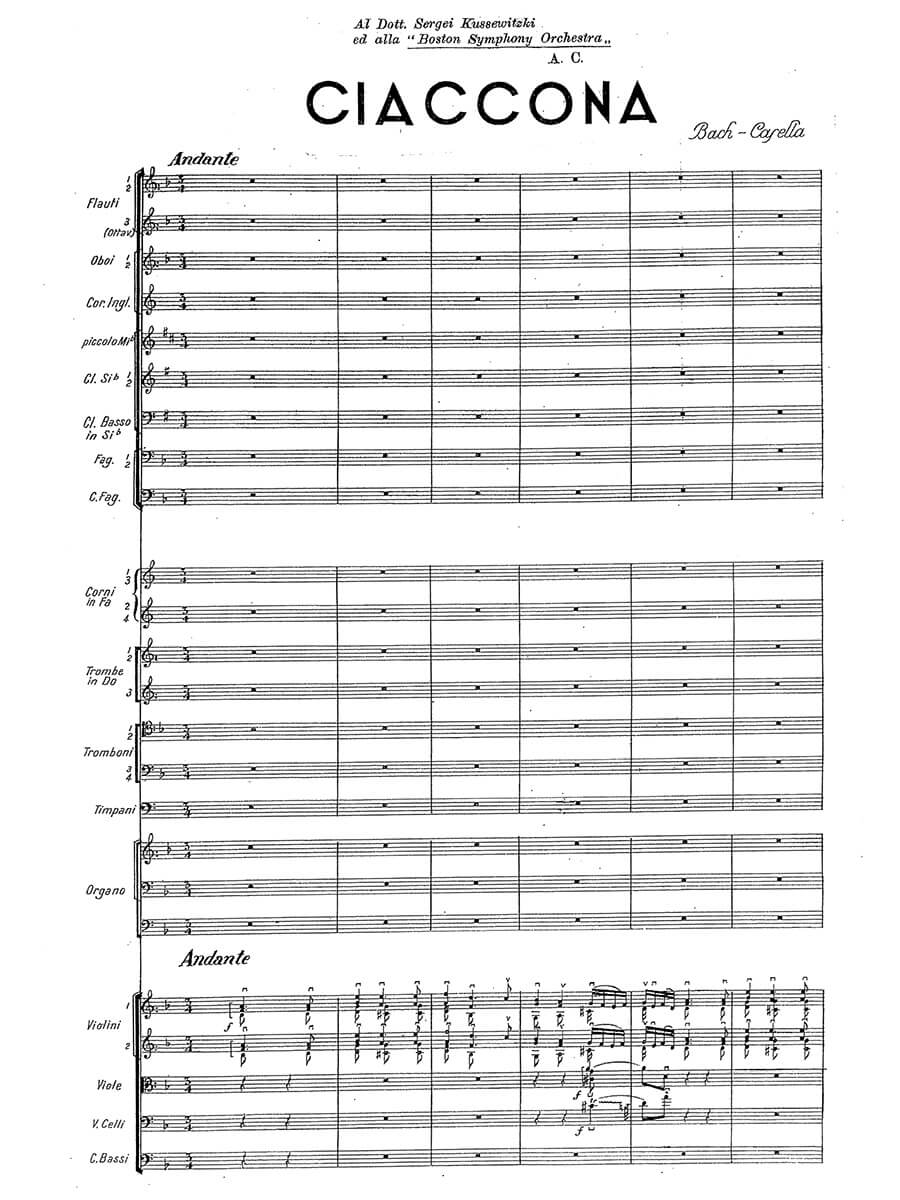Ciaccona’ from the 2nd Partita for Violin solo BWV 1004, orch. interpretation by Alfredo Casella
Bach, Johann Sebastian / Casella, Alfredo
23,00 €
Preface
Johann Sebastian Bach / Alfredo Casella – »Ciaccona« from the 2nd Partita for Violin solo BWV 1004, orch. interpretation by Casella
(b. Eisenach, 31 March 1685 – d. Leipzig, 28 July 1750)
(1720)
(b. Turin, 25 July 1883 – d. Rome, 5 March 1947)
Preface
Alfredo Casella
Alfredo Casella is the scion of a highly respected Italian family of musicians. His grandfather Pietro Casella, a friend of Nicolò Paganini, was a solo cellist in Lisbon and Turin. All three of his sons were also important cellists. The youngest of them, Carlo Casella, Alfredo’s father, deviated from the entertaining virtuoso line and had an immense passion for the solo suites of Johann Sebastian Bach, which Alfredo absorbed as ‘father’s milk’, so to speak. A close friend of his was Alfredo Piatti, at the time the most eminent Italian cello virtuoso and Alfredo’s godfather. While his father made a living as a sought-after teacher for as long as his health permitted, it was his mother, an extremely strong-willed, highly cultivated woman, who was responsible for Alfredo’s upbringing. Alfredo Casella was introduced to the best classical chamber music from an early age and received his first piano lessons from his mother at the age of five. He made astonishing progress, but soon proved to be exceptionally gifted and interested in the natural sciences, and two great men took a keen interest in his development: the physicist Galileo Ferraris (1847-97) and Italy’s leading symphonist Giuseppe Martucci. For several years it was not clear whether Casella would become a musician or a scientist. On April 15, 1894, he made his public debut as a pianist. He now received extensive musical training, read scientific books and Shakespeare excessively and learned German and French in a very short time. In 1895, he heard the Italian premiere of Richard Wagner’s ‘Götterdämmerung’ under Arturo Toscanini and memorized the score. His father died in August 1896.
Martucci and Antonio Bazzini had strongly advised that Alfredo should take up his official studies outside Italy, and so in September 1896, under the most modest economic circumstances, he moved with his mother to Paris, where he enrolled at the Conservatoire. He remained in Paris until 1915, in that metropolis of the vibrant renewal of the arts, where he made his way to the top. He cultivated close friendships with Maurice Ravel, George Enescu, Pablo Casals and, from 1911, Igor Stravinsky and many others. As disappointing as his piano studies were for him in human terms – despite the fact that he made a respected name for himself as a pianist – the horizon that opened up when he joined Gabriel Fauré’s composition class after the turn of the century, where Jean-Jules Roger-Ducasse, Charles Koechlin and Maurice Ravel were among his fellow students, was just as great. He was enthusiastic about the symphonic music of Richard Strauss and Gustav Mahler and wrote his First Symphony op. 5 between January and July 1906, the score of which was soon published by Mathot. He married for the first time in 1907. The marriage was not a happy one and they divorced in 1919. In August 1907, he completed his orchestration of Mili Balakirev’s oriental piano fantasy ‘Islamey’, which was enthusiastically received by the composer. …
read more / weiterlesen … > HERE
Score Data
| Edition | Repertoire Explorer |
|---|---|
| Score Number | 4865 |
| Genre | Orchestra |
| Pages | 68 |
| Size | 210 x 297 mm |
| Printing | Reprint |
